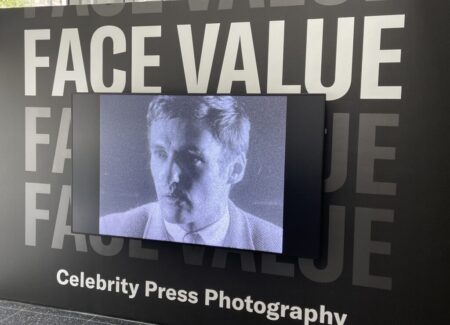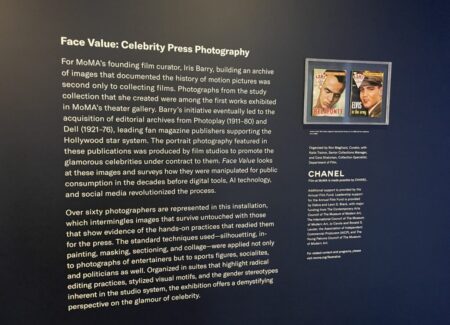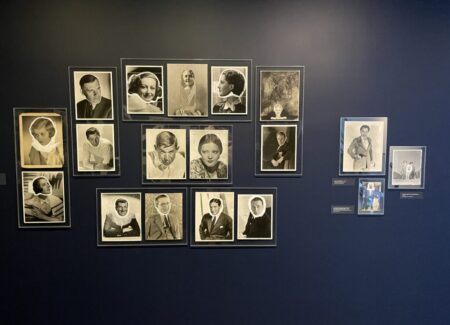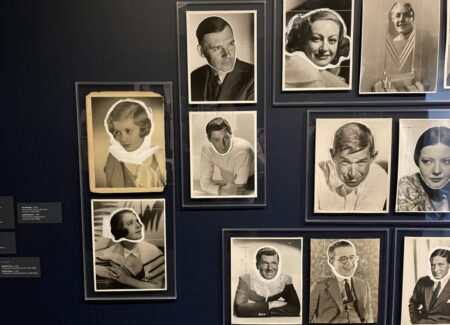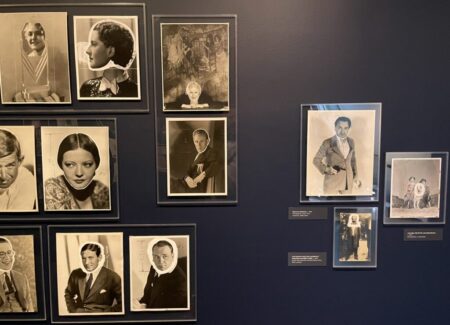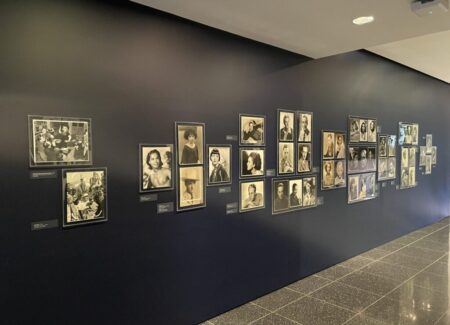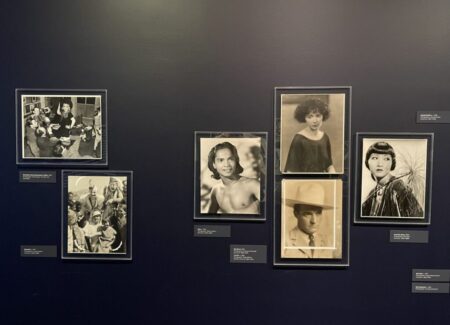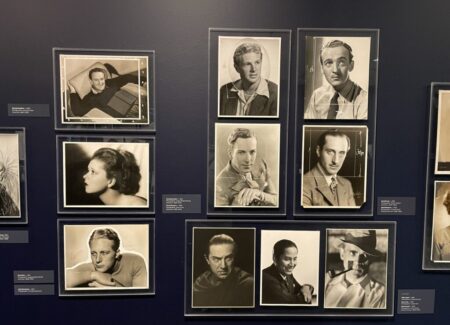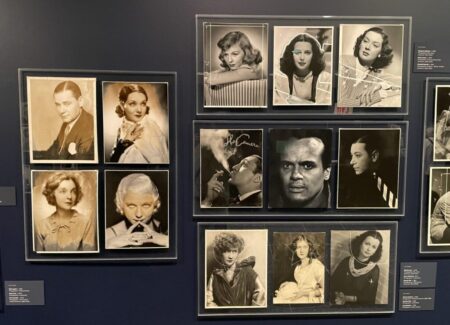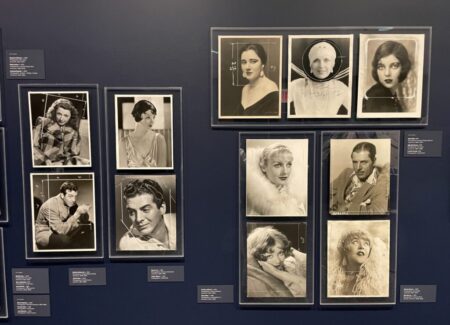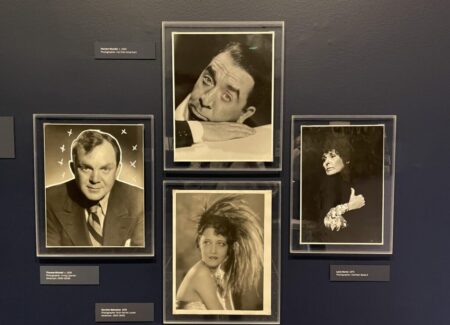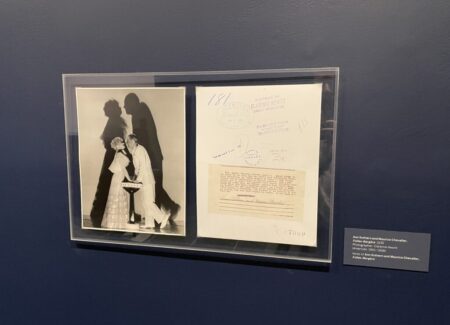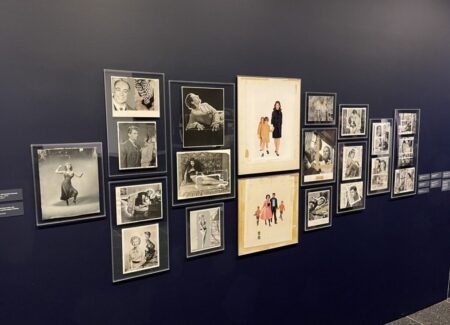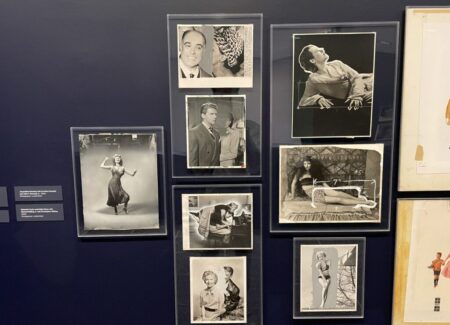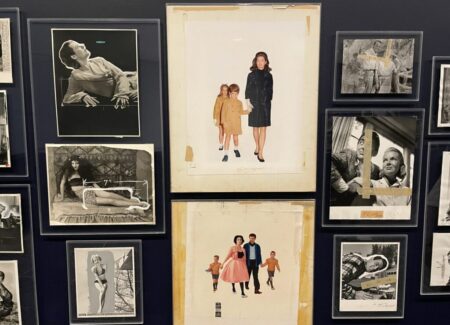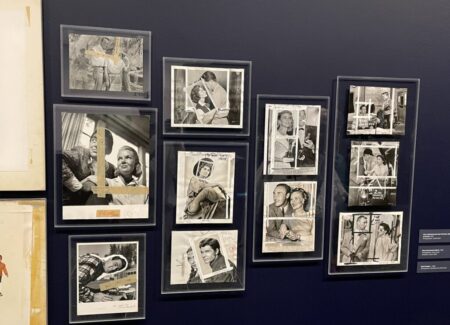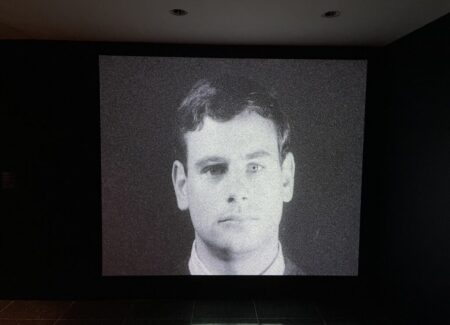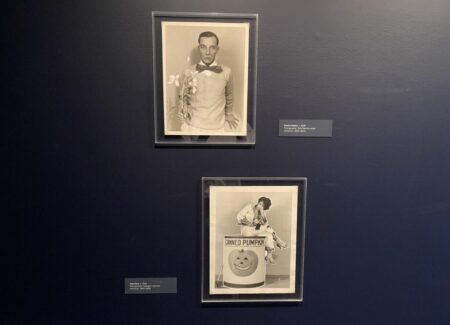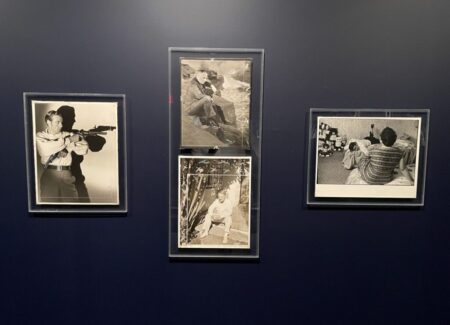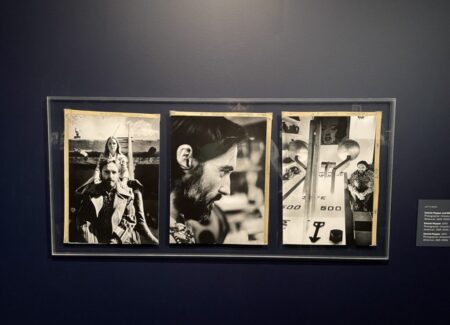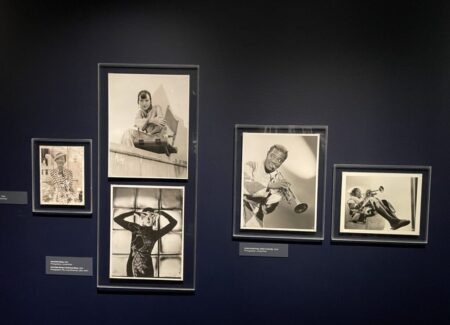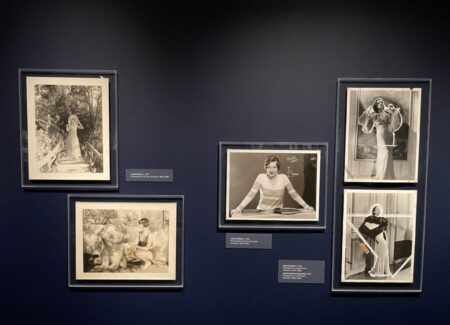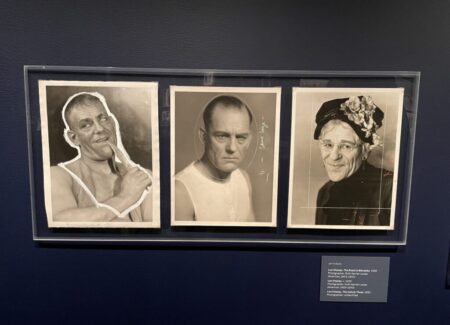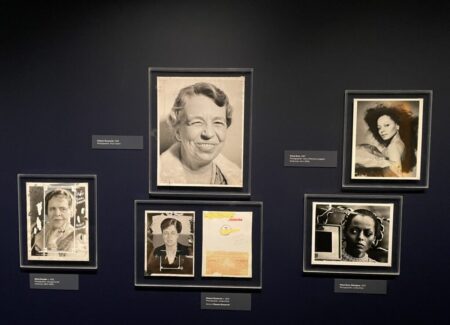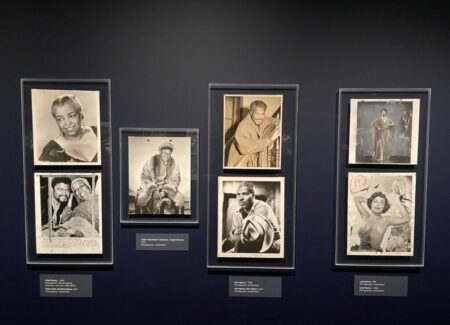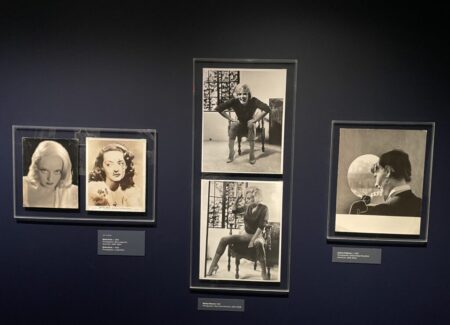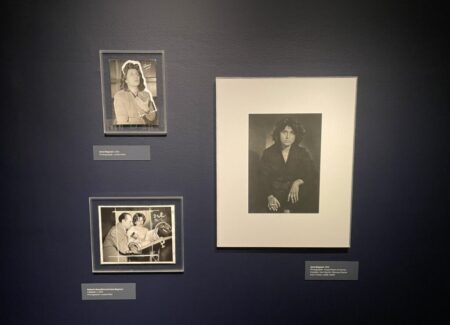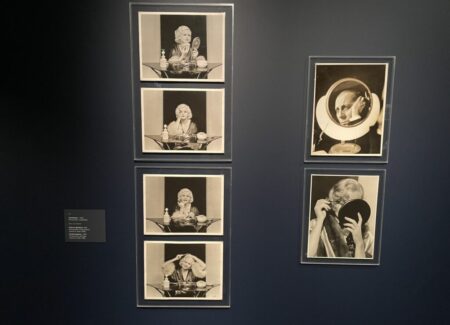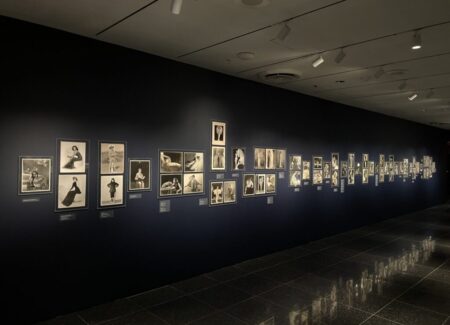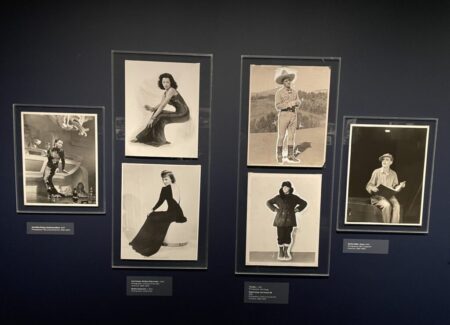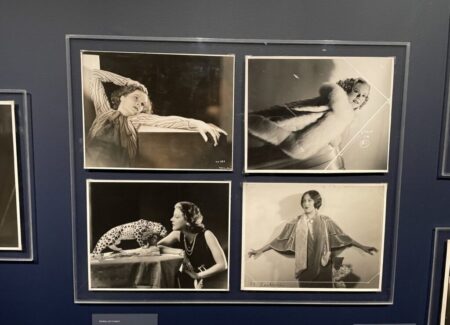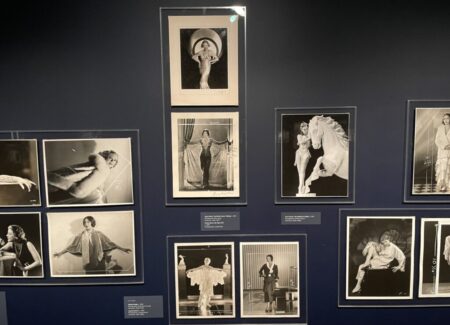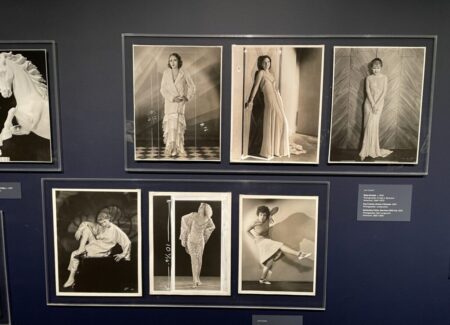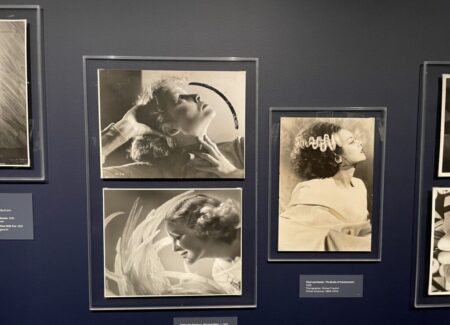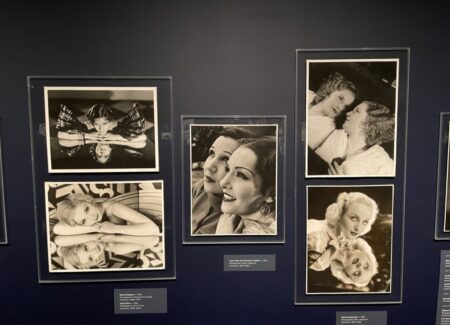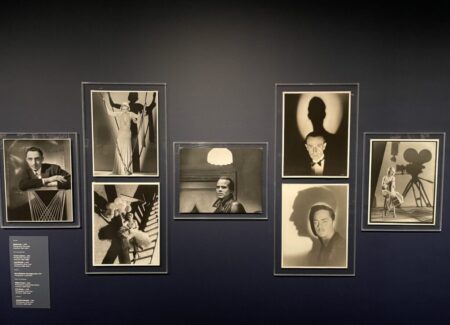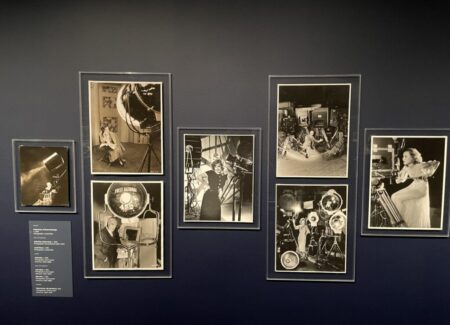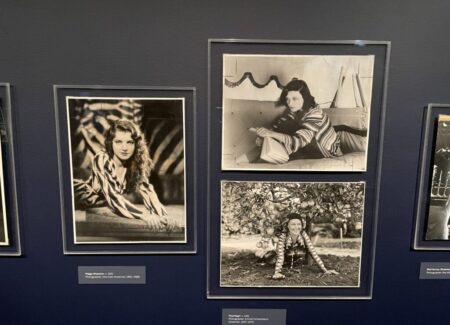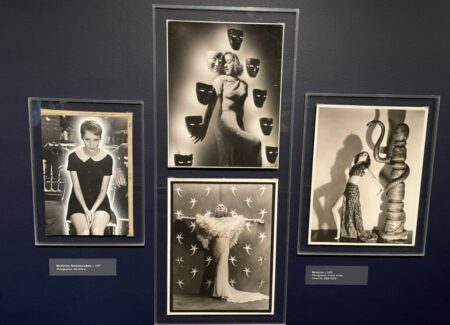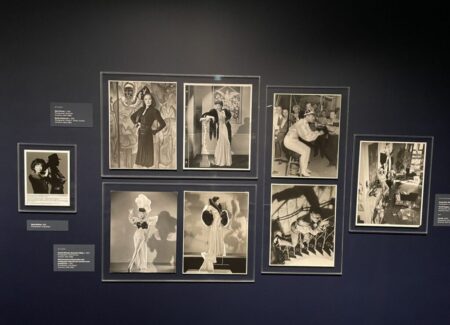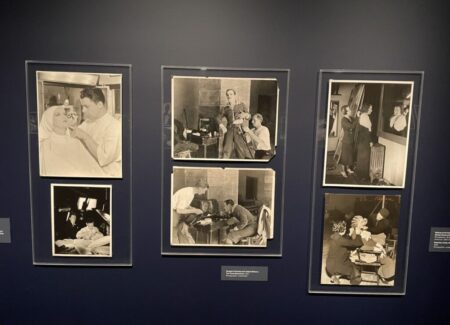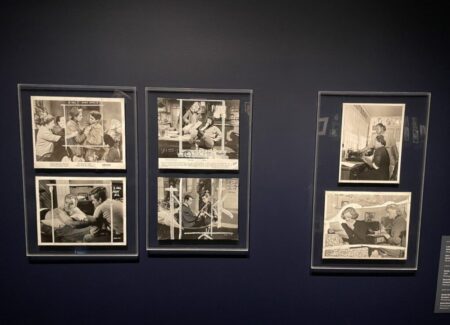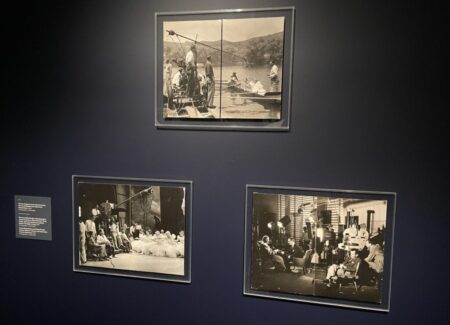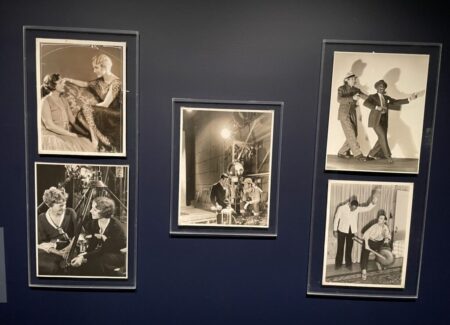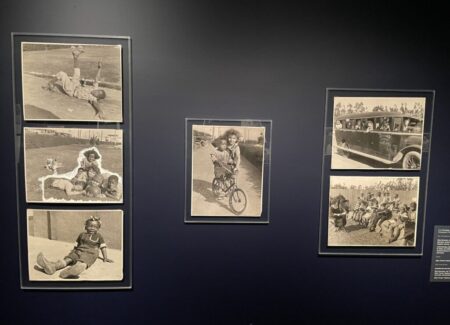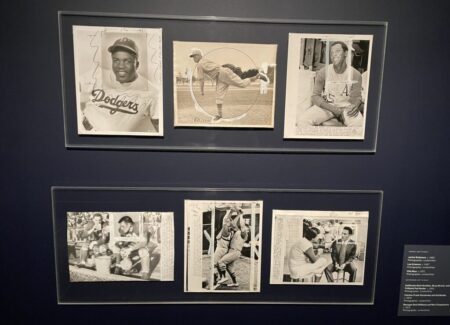JTF (just the facts): A group show consisting of over 200 black-and-white and color photographs from over 58 photographers, variously framed and matted, and hung against dark blue walls in the entry gallery and down in the main film projection gallery. (Installation shots below.) The exhibit was organized by Ron Magliozzi, Katie Trainor, and Cara Shatzman.
The following photographs have been included in the show. No print process information was provided:
- 80 anonymous/uncredited, 1921, c1922, 1926, 1928, c1928, c1929, 1930, 1931, c1931, 1932, c1932, 1933, c1933, 1934, c1934, 1935, c1935, cc1936, 1937, c1940, c1941, c1942, 1943, c1943, 1944, 1946, c1947, 1948, c1948, 1950, c1950, 1951, 1952, 1953, c1956, 1957, 1958, 1959, c1963, 1966, 1967, 1960s, 1970, c1970, c1971, 1972, 1975, 1976, 1993
- 2 anonymous/uncredited (magazine covers), 1958, 1959
- 10 Clarence Sinclair Bull, 1923, 1928, c1929, c1932, c1933, c1934, c1940, c1944
- 10 Otto Dyar, c1927, 1929, c1931, c1932, c1933, c1935, 1930s
- 10 Ray Jones, c1929, 1934, c1934, c1937, c1939, 1930s
- 8 Elmer Fryer, c1929, c1930, c1931, c1932, c1933
- 8 Bert Longworth, 1930, 1932, c1932, 1933, c1933, c1934, 1937
- 8 Ruth Harriet Louise, 1926, 1928, c1928, c1929, c1930
- 8 Eugene Robert Richee, 1930, c1930, c1931, c1932, c1937, c1941
- 7 Dick Stagg, c1924, c1925, c1927
- 5 George Hurrell, c1930, c1931, 1933, c1934
- 5 Irving Lippman, 1930, c1933, c1937, c1939
- 4 Ernest A. Bachrach, c1928, c1930, c1932
- 4 Don English, 1930, c1931, 1932, c1932
- 3 Russell Ball, c1929, c1933, c1934
- 3 Robert Coburn, c1937, c1939, c1942
- 3 Gene Kornman, c1927, c1937, c1938
- 3 Frank Powolny, c1931, c1940, c1944
- 3 Orlando Suero, 1970
- 2 Irving Chidnoff, c1929
- 2 Earl Crowley, c1931, c1932
- 2 Carl Dial, c1934
- 2 Jack Freulich, 1933, c1934
- 2 Roman Freulich, c1931
- 2 Allan Grant, 1962
- 2 James Manatt, 1932, 1935
- 2 John Miehle, 1930, c1931
- 2 Adolph L. “Whitey” Schafer, c1940, c1942
- 1 Sergis Alberts, c1928
- 1 Virgil Apger, 1935
- 1 Fred R. Archer, c1929
- 1 Kathleen Ballard, 1975
- 1 Bob Beerman, c1953
- 1 Elwood Bredell, c1930
- 1 Brown Brothers, c1906
- 1 James Brown, c1954
- 1 Lansing Brown Jr., c1929
- 1 Paul Calvert, 1938
- 1 Pat Candido, 1938
- 1 Arto de Mirjian, c1931
- 1 Preston Duncan, c1929
- 1 Eddie Fisher, 1960s
- 1 William Fraker, c1934
- 1 Ruby Berkley Goodwin, c1948
- 1 Phillip Harrington, 1956
- 1 Clarence Hewitt, 1935
- 1 George P. Hommel, c1929
- 1 Imandt, c1939
- 1 Yousef Karsh, 1959
- 1 Clifton L. King, 1935
- 1 Harry Philmore Langdon, 1987
- 1 Gene Lester, 1958
- 1 Hal McAlpin, 1934
- 1 J.C. Milligan, 1919
- 1 Edward Thayer Monroe, 1924
- 1 Hal Phyfe, c1930
- 1 Emmet Schoenbaum, c1931
- 1 Ned Scott, c1941
- 1 Raymond Stagg, 1916
- 1 Anthony Ugrin, 1933
- 1 Alfredo Valente, c1955
- 1 William Welling Jr., c1933
- 1 Ray Wilson, c1967
- 1 William Read Woodfield, c1953
- 1 Jack Woods, c1942
The show also includes the following film projections:
- Andy Warhol, 4 black-and-white films, 1964
- Danny Williams, 2 black-and-white films, c1965
Comments/Context: One of the byproducts of organizing curatorial teams at large museums into departments by medium, where the collections of paintings, drawings, sculpture, and photography are studied and supported by separate groups of people, is that sometimes caches of photographs end up where we might not expect them. This is certainly the case with photographs that document artistic performances, land and Earth art, architecture, artist studios, candids of artists’ lives, and exhibition installations – often these photographs are housed in departments other than the main photography section, and are included in exhibitions for different reasons than the photography curators might typically employ.
This surprisingly large photography exhibit (weighing in at more than 200 images) has been organized by MoMA’s film curators, drawing from the film department’s extensive collection of Hollywood still photography, the first major exhibit of such imagery at the museum since the early 1990s. The broader collection of photography within the film department includes plenty of photography: film stills (still photographs of actors in scenes from feature films made during the process of filmmaking), off-camera stills, candids, publicity portraits (provided by the studios to newspapers and magazines to promote the films and stars), premiere pictures, and other ephemera, including the editorial archives to two leading fan magazines. This exhibit centers of the important role of photography in the manufacturing of golden age Hollywood celebrity, particularly in the way that actor headshots, looks, publicity portraits, and other related imagery were made and manipulated by studios (using pre-digital methods) to build the awareness and popularity of their stars.
For the most part, this is a show about who’s in the pictures, and not who made them. A large number of the images on view here are uncredited, the maker unknown or now forgotten, while many of the known photographers worked inside the studio system, in portrait galleries set up and run by the studios to generate exclusive imagery. Of those most represented in this show, Clarence Sinclair Bull worked at Metro-Goldwyn-Mayer; Eugene Robert Richee and Ruth Harriet Louise made stills and portraits at Paramount; Elmer Fryer worked at Warner Bros.; Ray Jones worked at both Paramount and Universal; Otto Dyar started at Paramount and later moved to Fox and MGM; and Bert Longworth began at MGM, worked at Paramount, and eventually ended up at Universal.
The implicit argument that Face Value is making amplifies the idea that the studio had “products” to promote – in its upcoming films, its established stars under contract, and in its new talent – and so they developed a sophisticated photographic system (staffed by full time photographic professionals) to generate (and circulate) the imagery they needed. Just as it is today, attention was the key metric in this star system, and so glamorous photographs that could help build awareness and popularity were desired. And if the resulting photographs needed editing and cropping to make them even more effective, the image artifacts on view here are ready evidence that the studios were consistently manipulating their imagery within the boundaries of the analog techniques of the day.
The exhibit is organized as clusters of visual ideas and techniques, with small selections of headshots, portraits, and on set publicity stills arranged in thematic groups. Many of the themes involve hands-on physical manipulation of the prints: isolating heads with white paint/shadow, removing (erasing/masking) nearby figures with grey paint, cropping and re-framing with white paint, tape, or grease pencil (with little respect for the framing of the original photographer), and the full removal of backgrounds. In each case, an unnamed editor is starting with a finished photograph and reworking and reimagining it for better public consumption – amplifying certain characteristics, diminishing others, and removing anything (or anyone) that would distract from the central subject or desired mood. The prints allow us to essentially see this decision-making process from the inside, with the raw material of heads, faces, several kisses (and one bite), various dramatic poses and pairings, a dog (Rin Tin Tin), a pile of kids (the Little Rascals), and even a set of legs (belonging to Myrna Loy) pulled out from their photographic surroundings and repurposed.
When the original photographs are essentially untouched, we get a better view of the compositional strategies the many photographers were using to create visual energy and excitement. One long wall gathers together small groups of images of the same star as seen in two or three photographs, allowing us to see variants from a single session, experiments with props, or impressions by different photographers. Across the way, the image clusters are more thematic, with stars looking at mirrors, in seated poses, with arms outstretched, standing, reclining, in long gowns, wearing stripes, and seen in profile close up. Other creative approaches included mirrored faces (creating doubled effects) and cast shadows (either of the star’s body or perhaps a nearby prop), as well as fourth wall breaking via the inclusion of lighting fixtures and movie cameras, off camera moments with stars getting their makeup done, and even wider full scenes of a star in the midst of the entire movie making apparatus.
For many visitors, all of this conceptual thinking about the manipulation of celebrity will be overwhelmed by the power of the stars themselves, and in this way, the show is simply a parade of superlative portraits of Hollywood’s most famous. Standout images include portraits of Anna May Wong (with her fingers over her eyes), Gary Cooper (with two guns and a deep shadow), Buster Keaton (with a wide bow tie and a lily), Louise Brooks (standing on a bridge), Boris Karloff (with a pipe), Joan Crawford (in a striped sweater), Carole Lombard (reflected in a mirror, and in another image, posed with wires and shadows), Jean Harlow (putting on makeup), Tom Mix (with his cowboy hat), Gloria Stuart (with some feathers), Clara Bow (sitting on an oversized can of canned pumpkin), and Miriam Hopkins just generally looking dismissively seductive. If you’ve got your own favorite 1930s era Hollywood star, odds are good that he or she can be found here somewhere, probably looking fabulous.
As a thoughtful survey of Hollywood’s pre-digital construction of celebrity, Face Value hits its marks, even if it doesn’t shine a light on the original photographers as much as they deserve. In the best sense of the word, this show is nostalgic, both for the glamour of those early Hollywood film stars, and for the hand-crafted in-painting and cropping on view here that helped make their larger-than-life personas seem even more real.
Collector’s POV: Since this is a museum exhibition, there are of course no posted prices, and given the large group of photographers, credited and uncredited, included here, we will forego our usual discussion of individual secondary market histories and gallery representation relationships.
